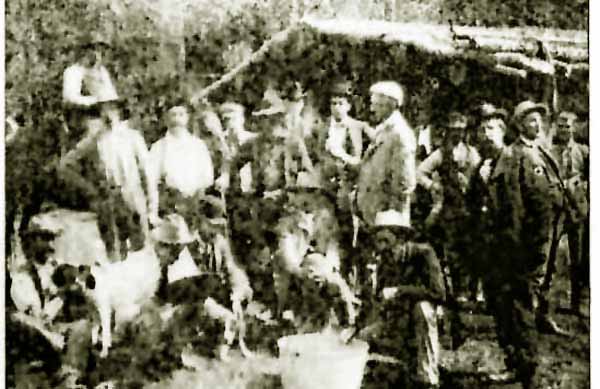
Investors on excursion tour of future site of Grand Encampment, 1897. Willis George Emerson believed to be
gentleman in dark suit toward right hand side of photo.
The town and the Ferris-Haggerty Mine were actively promoted by Willis George Emerson (1866-1918) and his partner
Bernard "Barney" McCaffrey (1844-1911). Emerson is
commonly regarded as the founder of
Encampment and is remembered in the name of Emerson Blvd. Emerson was previously involved in the promotion of sugar refining mills in southwest Kansas, a townsite and irrigation company in
Idaho, and gold mines in Colorado. He would later be involved in various schemes in Nevada, California, and finally his greatest stock fraud, the Emerson Motor Company. Although Emerson took
credit for the founding of Grand Encampment, the town itself, however, was orignally surveyed at the instigation of
local landowners and mineral claimants, Jim Rankin, Malachi W. Dillon and Charles O'Connell. Emerson came upon the scene about 1897 from
Cripple Creek, Colorado, where he was the president of the Little Puck Gold Mining Co.
In Cripple Creek following Emerson's departure from the scene, untoward accusations appeared in the
Colorador Springs Gazette with regard to
the sale of the Jack Pot Mine. The sale commanded a comparitively high price,
higher than knowledgable miners thought justifiable. But the mine had reportedly paid large dividends to its shareholders.
In the years 1899 and 1900 alone it paid out
some $75,000, a price which would justify the high price paid for the mine. The new owners, however, did not realize the earnings
that had been represented. Thus, accusations appeared that the mine had been "salted." The new owners sued.
More likely, the dividends declared were not warranted by the actual earnings but were paid out from the sale of
"treasury stock." The case was settled with the original sellers
repurchasing the mine for fifty-one cents on the dollar. Thus in after sight, there may have been good reason for
Emerson leaving Colorado.
Emerson, himself had moved to Colorado from Idaho where he, with with Charles N. Lee, J. B. Holmes, D.W. Hgbee and McCaffrey began an irrigation scheme near the little
town of Eagle Rock. Previously, Higbee had been involved with Emerson in the "Kansas Sugar Swindle."
Eagle Rock had fallen on hard times. It had been the location of railroad shops for a narrow gauge railway providing
access to the outside world for Montana. In 1885, mainly due to the presence of railway workers, the town had a population of approximately 1500. Two years later in 1887, the
ailway shops moved to Pocatello, Idaho, and the population precipitiously dropped so that by
1890 its population stood at 472. That year, the Eagle Rock Land and Townsite Company was chartered. Also chartered was the
the Great Western Canal and Improvement Company. Sale of lots, however, was promoted under the name of "Idaho Falls." It was not until the following year, with due formality
that the name of Eagle Rock was changed to Idaho Falls. The actual falls were some five miles away. Today, Emerson, Lee, Holmes and Higbee are honored by the names of
streets in Idaho Falls. In later résumés Emerson took credit for the renaming of the town. By 1894, Emerson and McCaffrey were maintaining an office in Chicago in the
Chamber of Commerce Building advertising their experience in Irrigation notwithstanding that the Great Western Canal had not yet been completed. Later the canal was sold
to the New Sweden Irrigation Distict.
In Kansas, after receiving his law degree and being admitted to the Bar, in 1887 Emerson appeared in Mead County. In that year, he, with others,
formed the American Mortgage Trust Company. Others who later appeared with Emerson in various promotions included
A. H. Heber, E. T. Brawley and D. W. Higbee. In the "Kansas Sugar Swindle," in the words of the Meade County News, Nov. 1, 1906, p. 4. Emerson filched from Western
Kansas Municipalities two and one-half million dollars in bonds and subsidies for fraudulent "Adamson" or "Roasting sugar plants." The scheme involved the
sale of County scrip which would be used
for the construction of mills to refine sorghum into sugar. The scrip would be redeemed by refunding bonds issued by the
sugar company. Local farmers would gain by having a market for the sorghum. A demonstration sorghum mill was constructed to convince the farmers that the system would work.
Free booze and free transportation was provided to the demonstration of the new process.
The demonstration produced refined sugar.
With the success of the demonstration, the farmers purchased the refunding bonds. Contracts were signed for
the crops of sorghum to feed the new mill. Unfortunately, when the crops were ready, the mills were not. The refunding bonds were worthless.
The farmers lost their investments.
In the words of the Meade County News,
Emerson and others involved in the scheme "vamoosed" to the west. The vamoosal may have been motivated when it was revealed that the
refining demonstration had been secretely sweetened by the addition of barrels of brown sugar into the sorghum syrup.
The American Morgage Trust Company went into receivership and its entire assets sold for
$300.
There may have also been an additional incentive for the hasty departure from Kansas. At the time, the natives were restless and seemed to have itchy
trigger fingers. Residents were engaged in the
"County Seat Wars" with rival townsite companies having been formed. Two sheriffs were killed in the warfare. Threats of asassination were made against
District Judge Theodosius Botkin, indeed, to such an extent that while presiding in court, the judge kept a
Winchester and two Colt revolvers on hand at the bench. The judge was subsequently empeached but not convicted, for alleged drunkedness on the bench. During the trial before the
Kansas State Senate it was inferred that Emerson was involved in possible solicitation of bribery of a county attorney
in order to preclude lawsuits against or prosecution of the sugar
company. See Trial of Theodosius Botkin, Vol 1, page 642. Later, Judge Botkin took the "Keeley Cure" for alcholism. The Keeley Cure was one in which
alcoholism is cured through the injection of gold chloride. Following the cure, he was elected to the
state legislature.
In 1897, the Grand Encampment Townsite Co., was organized with
Emerson as president. Rankin, O'Connell, Tom Sun, and Dillon, among others, were minority shareholders. How much Emerson and his compatriots from
Cripple Creek contributed monetarily may be questioned. The value lay in the land and the mineral claims Perhaps as a harpenger of things to come, in 1900 the minority shareholders
filed suit alleging that since the oganizational
meeting of the Grand Encampment Townsite Company, Emerson and his associates refused to call a meeting or give any reports as to the financial standing of the company.
It was alleged that Emerson and the others had disposed of a large amount of the property. They requested that a receiver be appointed and they they be awarded
damages of $50,000 and that a recission of all transfers of property by the corporation be ordered. Judge Craig appointed a receiver.
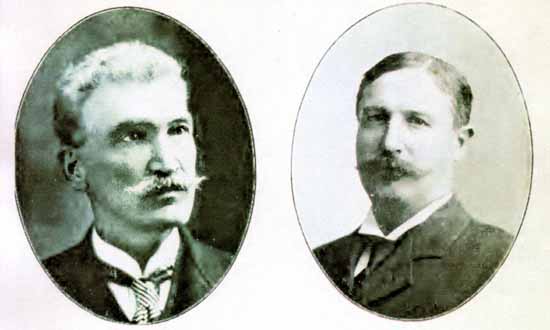
Left: Bernard McCaffrey; Right, Willis George Emerson.
Additonally, Emerson and McCaffrey formed the North American Copper Co. which constructed the
Smelter and tramway. The smelter and tramway cost about $1,000,000. Five Million Dollars worth of stock was sold.
Although Emerson was the promoter, McCaffrey was the one who would put Emerson's vision into reality.
The Encampment Herald described Emerson as the steam and
drive wheels of a locomotive, "while Barney McCaffrey acted as the governors and the sand on the track." In other words while
the two were together, McCaffrey kept Emerson under control. Emerson was a novelist and in one of his numerous books, The Builders set in
Idaho Falls, cast
McCaffrey as one of the characters. Emerson described Barney as having a commanding presence. Emerson used Encampment as the setting of his
1915 novel The Treasure of Hidden Valley in which Jim Rankin, Tom Sun, and Boney Earnest appear as
characters.Emerson was not the only novelist resident in Encampment. Charles Edward Winter in his
1907, Grandon of Sierra described McCaffrey:
He was a man of striking appearance; six feet tall, straight as the traditional Indian, with his shoulders squared in the manner that proclaims a military
experinece He wore his grey hair brushed straight back from his forehead. He was courtly in manner after the old school, graciously differential toard women, friendly, direct and
courous with men. His eyes, grey and lear, regard on steadily through his steel rimmed classes; his face was
determined but kindly -- a western man."
As later noted, in 1904 the pair
separated. Emerson moved to California and
Nevada and engaged in more promotion of land and mining schemes and just as importantly himself. About 1910,
Emerson picked up the title "Colonel" and bragged of his honorary membership in the
Grand Army of the Republic. McCaffrey returned to Denver. At the time of McCaffrey's death in 1911 there were kind memories of him in
Encampment. The Herald described him as "prodigal of his kindly acts, scattering
them broadcast with lavish hands, as a man would scatter wheat; and asking nothing at harvest time, and
thousands there are who will revere his memory as one of Nature's noblemen." Memories of Emerson at the time of
Emerson's death in 1918 were less kind.
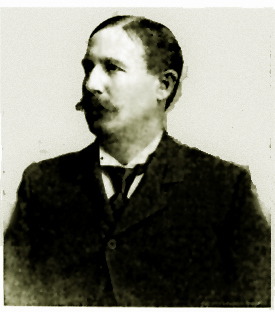 Willis George Emerson Willis George Emerson
In a similar manner to the organization of the North American Copper Co.,
Emerson and McCaffrey formed the Black Tiger Copper Mining Co. Emerson was the promoter and McCaffrey was in charge of the physical
development of the mine.
Black Tiger was capitalized at $1,000,000. The stock was allegedly "fully paid" and
non-assessable" The stock was underwritten by the "Federal Securities Co." of Chicago. Federal Securities was in actuality
organized and owned by Emerson. Beginning in 1902, the Black Tiger stock was heavily promoted in eastern newspapers on the basis that
Professor W. S. Eberman had made a detailed report which indicaed that the proposed mine had excellent
copper. Professor Eberman had worked as a chemist for the Minnesota Dairy and Food Commission analyzing milk. He moved west and for
a period of time resided in Encampment and became wealthy
acting as a mining consultant.
Advertisements claimed that the
company was drilling a mine tunnel would soon reach Professor Eberman's rich vein of copper. It was claimed that the price of the stock
would be increased from ten cents a share and was "liable to jump in a single
day up to $2.00 or $3.00 per share, or more." The advertisments promised bank references. The references were from a bank controlled by
Emerson's North American Copper Co.
In addition, to the use of Chatterton's name, Emerson
attempted to draw Senator F. E. Warren's name into the web by claiming that
Warren was a shareholder. Unsolicitedly, Emerson had registered a block of stock in Warren's name and sent the stock certificate and a
prospectus to his office. The offer of the stock was refused, but not until
after Warren's name had been used. In July 1903, United State Investor magazine in response to a shareholder
inquiry gave an extemely negative assessment of the stock, "the company has no ore of any kind in sight, that while it has apparently sold
thousands of dollars worth of stock to the general public. It does not seem to care about
keeping up development work or control of the property." The assessment concluded, "The stock Is not believed to be worth one cent a share,
and »e should advise you to steer clear of the proposition." Within a year, the fact that the promotion of the stock was faudulent was exposed. By 1905, the
company was defunt and those that had invested lost their innvestments.
In the fall of 1912 a month before the 1912 election, the offer of the Black Tiger stock to Senator Warren became an election issue.
Collier's Magazine, published a scathing article regurgitating every claim of wrong-doing against Senator Warren that
had been made over the previous twenty years. The response by
Senator Warren was that the the first draft of the article had been written by Willis George Emerson as revenge for refusing to assist Emerson with the
Black Tiger Copper Mine. It was claimed that a proposal had been made that Warren could prevent the article from being published by purchasing the article for $10,000.
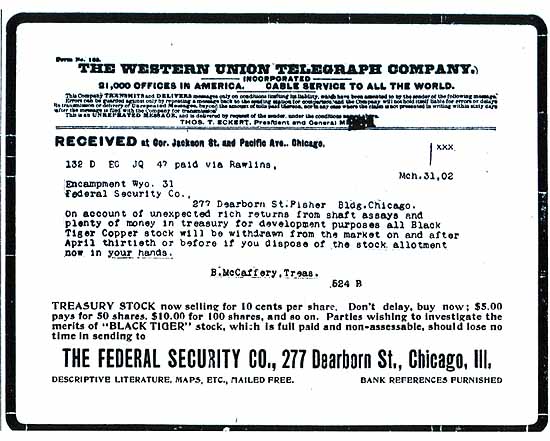
Advertisement for Black Tiger Copper Mining Co. stock, 1893
Emerson was involved with the North American Copper Co. which had acquired the operation from the original developers. The North American Copper Co. constructed the
smelter and tramway for about $1,000,000. In 1904, Under the weight of various frauds and inflated values of assets, the company financialy collapsed. North American
Its operation were purchased in exchange for stock in the Ferris-Haggarty Copper Mining Co. which itself became financially embarrassed.
was then sold in exchange for "watered stock" in Penn-Wyoming. It was later charged by some of those defrauded that the
actual consideration for the purchase of the Penn-Wyoming Mine was $300,000 but was carried on the books
for over $1,000,000, thus giving an artificial and fictitious value to the Company. "Watered stock" are
artificially inflated in value by a variation on a "Ponzi scheme; that is, by the declaration of
Dividends paid out of proceeds of the sale of yet more stock
and an artificially high par value. The term "watered stock"
originally referred to livestock sold by weight in which a stockgrower force fed water to the herd so as to artificially increae the
weight of the cattle. But in the new transaction Emerson did not profit. In Emerson's words, he was "frozen out."
Following Emerson's death in 1918, the Prescott [Arizona] Journal Miner, after referring to Emerson as having
creating ""one of the largest
mining swindles of the age," summed up the Encampment frauds:
"The method pursued by the company was to pay dividends to certain stock issues for a period of
six per cent, later incrasing to eight per cent. While the mine showed excellent
bodies of copper ore, which was stated to be in excess of
20 per cent in value the returns from the smelter showed slightly in excess to four per cent. The superintendent's report
showed a vein 10 feet wide, 75 feet deep and 350 feet in length, in 1907, but was shortly after this that the company gave way in
miserable failure.
The Cheyenne Leader noted of the failure of copper mining scheme, "The facts are that the Penn-Wyoming project was
picked up by crooks who exploited the property three different times
to draw large sums of money for the sale of stocks from eastern people and even from Europe."
An additional method of artificially increasing the value of the stock in a corporation was to form other interrelated corporations
which then exchanged stock showing the value of the
exchanged stock as "par" and by holding unissued stock as "treasury stock," showing it to be an asset of the
corporation. In this manner, a business could be capitalized at millions of dollars when it in
essence held no real assets.
In 1903 while these manipulations were at their height, Emerson dreamed up a more audacious
scheme. Out west of Casper and south of Moneta in Fremont County lies the
confluence of Muskrat Creek and the Wind River. There amongst the sage brush at the very geographical center of Wyoming, Emerson proposed to construct a new
city. The city would be connectd to rail lines by an extension of the Northwestern west from Casper, an extension of the Burlington System south from
Frannie, and an extension of the Union Paciic northward. The new city, to be named "Emerson," would boast a University. The crowning feature, however,
was that the City of Emerson would replace Cheyenne as the capitol of the state. The plan, hwever, fell apart when prematurely, before it could be sprung upon the voters in the
1904 election, it was exposed by the Wyoming Tribune. Cheyenne and cities along the Union Pacific were against the plan, altough cities such as
Cody, Lander, and Casper were in favor. The Cody Stockgrower and Farmer ridiculed Cheyenne's opposition:
E'en now, with eyes that pierce the future, I behold
A splendid city where stand mountains bound Sweetwaters Vale.
There spindling spires and turres bold
Reach oward the skies;
while spreading all around,
Great granite blocks are seen, and countless lovely homes
Builded 'mong rippling lakes, by many a shady park.
Methings that yonder where revealed are shining comes.
A stately capitol I surely mark.
"Dream" on, O glorious Willis George Emerson!
Things are now sweet morsels for the witty
Will soon assume real form. Thousand of men will run
And help to build and pupulate your city.
Howl, hungry Laramie and greed old Cheyenne:
(At howling you are both extremely handy!)
Grap--Denning, Chaplin, Lucas, Slack,Bond -- grap the pen
And go for Wilis -- biff, bang, bosh and bandy;
But sure as fate Wyoming' hosts will rally
And build a city in Sweetwater Valley.
Emerson may not have completely given up on the creation of a large city in the center of the state. In May 1917, he purchased from
the federal government 2,327.78 acres in the center of the state .
At the end of 1904, as above noted, the North American Copper Company, collapsed. As a result of his freeze out from
Penn-Wyoming, Emerson moved to California at the invitation of his old partner
from the Kansas Sugar Swindle
Anthony H. Heber. Heber was then engaged in the promotion of the
Imperial Valley through his California Development Company. Heber, California, is named after Heber. Emerson became the
president of six townside companies in the
valley of which Heber was one and Brawley, California is another. Emerson also purchased the
Rattlesake Mine near Goldfield, Nevada. He promptly recapitized it with watered stock and renamed it
The Bonnie Clare Bullfrog Mining and Milling Co., telling the Salt Lake Tribune, June 19, 1905, that it was
"without exaggeration" worth millions. He also promoted the "Carlsbad Consolidated Oil Company." Like all of Emerson's promotions,
it used grand newspaper promotions and promises of
grand returns. In 1906, Emerson's partner Heber burned to death when the Goldfield Hotel in which he was staying burned down.
Emerson sold his interest in the mining
company. In 1910, the California Development Company was declared insolvent.
Somehow magically Emerson always emerged unscathed, leaving in his wake bankrupt companies and indicted associates.
His last major pomotion was the
Emerson Motor Company which promised to build a five passenger motor car that would achieve about 24 miles to the gallon and sell for $395.00.
Promotional literature written by Emerson depicted the vehicle.
Unknown to the investors, the depiction of his proposed car was a redrawn vehicle from another motor car
manufacturer's catalogue. The venture was, in reality, a stock promotion. A car was displayed to prospective investors, but it
was that of another manufacturer, repainted and disquised. Advertisements addressed to potential investors
depicted a proposed glorious factory.
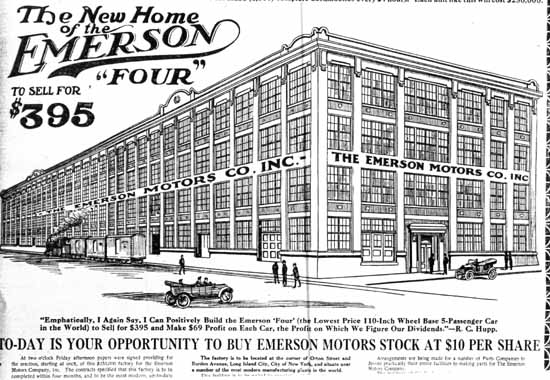
Proposed Emerson Motors Factory
At first, Emerson's advertisements claimed to have a site for its factory in Long Island City, New York. As of 2013, the site is a vacant lot with a graffiti
painted fence.
In order to answer criticism that Emerson Motors did not actually have a factory, arrangements were made for obtaining a small facility in
Kingston, New York. The reality was far different from that depicted in some of the ads.
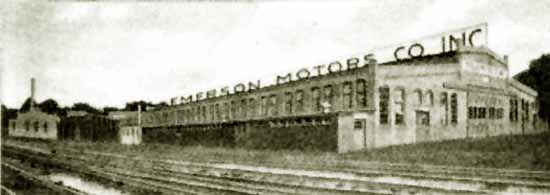
Actual Proposed Emerson Motors Factory in Kingston, New York.
The engine was planned to be
purchased from another manufacturer. No design had ever been made of the car except in the imagination. In 1916, the
New York Tribune did a major expose which excited the interest of the
United States Department of Justice. Emerson, along with others, was indicted for using the mails to defraud. One of the more
interesting items of testimony was that Emerson delegated to an employee the job of bribing a
Massachusetts District Attorney in Boston to avoid prosecution for the stock fraud. Emerson was however able to avoid trial and possible conviction by
being confined to bed suffering from apolexy, paralyzed and dying. On December 13, 1918, Emerson died at the home of his
son in Los Angles. His associates were convicted.
In March 1905, the smelter burned. It was rebuilt. The Grand Encampment Herald, May 3, 1907, reported that
40,000 tons of "blister copper" was leaving Encampment daily. Blister copper is an intermediately refined copper 98.5 to 99.5 percent pure.
It is so called from its blackened blistered appearance.
On May 10, 1907, the smeler again burned. Again, the smelter was rebuilt allegedly with the most modern equipment. At the
same time, operations were hampered by the lack of a railroad to carry the refined copper to a railroad. Coke for
smelting operations were required to be brought in from Walcott by freight wagons and the copper hauled out in the
same manner.
At the same time that the Company was suffering from the damage wrought by the fires and lack of railroad transportation,
a multitude of law suits were brought by shareholders of the various companies contending that various
actions of the respective boards of directors were fraudulent. While this was going on, the writers of
the industry bible, The Copper Handbook blasted the company for not providing full balance sheets and for payming dividends when
at the same time it found it necessary to issue additional stock to pay for its operations. The writers contended that if such
practices continued "Penn-Wyoming is liable to follow
its predecessor, the North American, to the scrap-heap."
As a result and in the face of various lawsuits, the Company reorganized as the United Smelters,
Railway & Copper Company. The Copper Handbook apologized for its
errors, admitting that an "an injustice, unintentional, but none the less real, was done Mr. Cobb [the president of Penn-Wyoming],
and for which a voluntary apology is tendered herewith." The Handbook noted the
corrective actions of the Company:
The Penn-Wyoming has suffered in the past from a variety of ills, but
substantial progress has been made toward the alleviation or elimination of
its various troubles, during the past eighteen months. The railway so badly
needed will be running within a few weeks. Underground openings have
been extended, the destructive fires of the past will be guarded against in the
future by steel buildings; litigation over titles has been decided in the company's
favor; payment of dividends while selling stock has ceased, and a full
balance sheet has been furnished shareholders. The cost-sheets of the 1906
and 1907 smelting campaigns show that copper in considerable quantities
can be produced at reasonable prices, and the ultimate success of the mine
is dependent solely upon its ability to furnish large tonnages for steady
smelting operations. The management is energetic, and, while laboring in
the past under many difficulties, and having done things that have been
criticised by the Copper Handbook, has made progress in the right direction,
and seems worthy of the confidence of the shareholders.
Charges of fraud brought against the officers of the Company were dismissed. But in actuality, the Handbook was
correct the first time and in a scathing report in Volume X deliniating the various frauds, lies, and deceits. Volume
10 of the Handbook concluded: "though it is perfectly safe to assume that several millions of
dollars have been diverted from the pockets of innocent investors by one of the most
flagrant swindles ever perpetrated in mining finance, and the entire gang should be
rounded up and jailed for common swindlers."
The Company's assets were foreclosed upon and copper production ended even though the mine
had not played out. State Leader in Emerson's obituary noted:
"About two years ago the extensive properties formerly held by Emerson
and later held by the Penn-Wyo Copper company were sold under order of the
Unites States district court at Cheyenne for less than
$200,000.
The splendid smelter which at the time of its ocmpletion was the
finest of the kind in the world is now rotting away in
disuse at Encampment, and is not even considered worth junking.
The railroad has deteriorated in a great extent and has not been operated for several years.
the aerial tramway has fallen down.
Today, only the foundations remain of what was once one of the largest
copper mining operations in the United States.
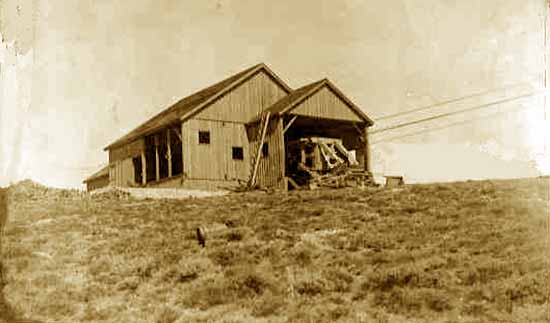
Cablehouse, Encampment
Next page, Encampment continued.
|